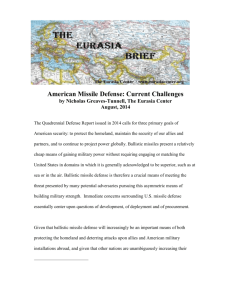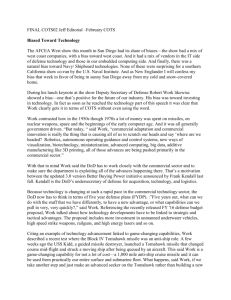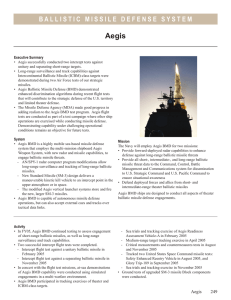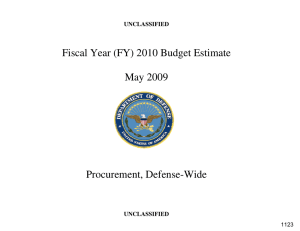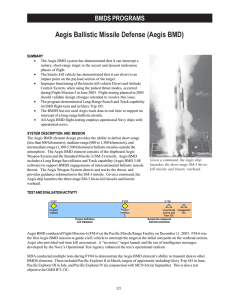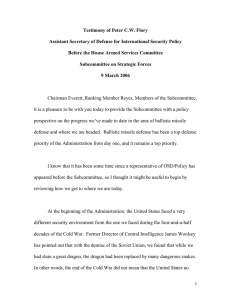Sea-Based Missile Defense AEGIS, the Standard Missile and Sea
advertisement
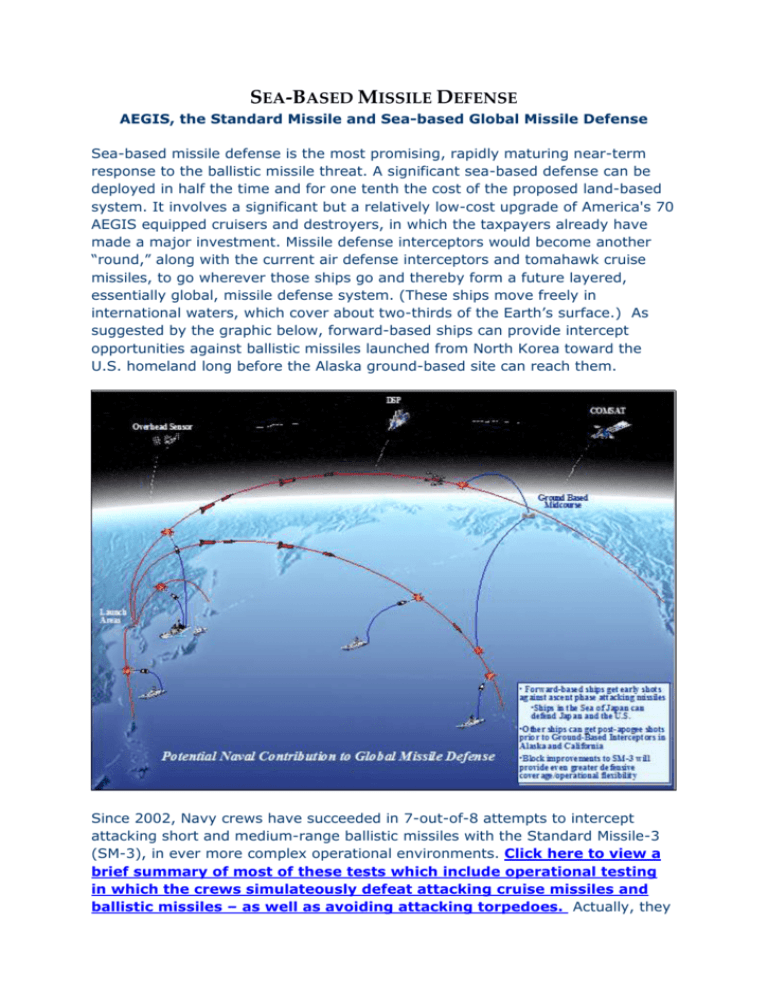
SEA-BASED MISSILE DEFENSE AEGIS, the Standard Missile and Sea-based Global Missile Defense Sea-based missile defense is the most promising, rapidly maturing near-term response to the ballistic missile threat. A significant sea-based defense can be deployed in half the time and for one tenth the cost of the proposed land-based system. It involves a significant but a relatively low-cost upgrade of America's 70 AEGIS equipped cruisers and destroyers, in which the taxpayers already have made a major investment. Missile defense interceptors would become another “round,” along with the current air defense interceptors and tomahawk cruise missiles, to go wherever those ships go and thereby form a future layered, essentially global, missile defense system. (These ships move freely in international waters, which cover about two-thirds of the Earth’s surface.) As suggested by the graphic below, forward-based ships can provide intercept opportunities against ballistic missiles launched from North Korea toward the U.S. homeland long before the Alaska ground-based site can reach them. Since 2002, Navy crews have succeeded in 7-out-of-8 attempts to intercept attacking short and medium-range ballistic missiles with the Standard Missile-3 (SM-3), in ever more complex operational environments. Click here to view a brief summary of most of these tests which include operational testing in which the crews simulateously defeat attacking cruise missiles and ballistic missiles – as well as avoiding attacking torpedoes. Actually, they are 1-out-of-2 in attempts to intercept targets in their ascent phase (while still rising from their launch pads) and 6-out-of-6 in intercepts of attacking ballistic missiles while they are descending from their maximum altitude. The SM-3 Block 1 is becoming operational – and High Frontier recommends that MDA turn it over to the Aegis Program Office for refinement and further improvements. In this regard, MDA would be following the approach taken when Patriot and PAC-3 were turned over to the Army for final development. Click here to read a 2000 paper by Ambassador Henry F. Cooper and Vice Admiral J.D. Williams (USN Retired) which examined the basic kinematic relationships involved in intercepting long-range ballistic missiles from the Sea of Japan. They found that even the relatively slow SM-3 Block 1 interceptor, now being deployed, has a limited capability for intercepting longrange missiles launched at the Western United States. They also recommended a series of improvements that would greatly increase the capability of the SM-3, for relatively modest investment in a more capable booster rocket and advanced technology that permits a lighter kill vehicle. High Frontier continues to recommend this approach for block improvements to the SM-3. Two ship classes in the United States Navy currently field the AEGIS radar and weapons package – Ticonderoga-class guided missile cruisers and Arliegh Burkeclass guided missile destroyers. Ticonderoga and Arliegh Burke Class TICONDEROGA CLASS ARLIEGH BURKE CLASS Guided Missile Cruiser Guided Missile Destroyer (AEGIS) (CG) (AEGIS) (DDG) Displacement: 9450 Tons Displacement: 9300 tons Dimensions: Length - 567 ft Dimensions: Length - 509 ft Width - 55 ft Width - 66 ft Speed: 30+ knots Speed: 32+ knots Cost: About $1 Billion each Cost: $945.9 million Crew: 24 Officers, 340 Enlisted Crew: 23 Officers, 300 Enlisted Armament: MK26 missile launcher (CG 47 thru CG 51) Standard Armamment: Standard missile; Harpoon; Vertical Launch ASROC Missile (MR) or MK41 vertical launching system (CG 52 thru CG 73) (VLA)missiles; Tomahawk ASM/LAM; six Mk-46 torpedoes(from two Standard Missile (MR); Vertical Launch ASROC (VLA) Missile; triple tube mounts); one 5"/54 caliber Mk-45 (lightweight gun); two Tomahawk ASM/LAM; Six MK-46 torpedoes (from two triple 20mm Phalanx CIWS Number in Fleet: 39 deployed, 5 under construction mounts); Two MK 45 5-inch/54 caliber lightweight guns; Two Phalanx close-in-weapons systems Number in Fleet: 27 deployed Additionally, the Japanese Kongo-class destroyers and Spanish F-100 frigates also house the AEGIS system. Cooperation with allies will be an integral part of sea-based global missile defense as our ships will have to cruise far from home in the littoral waters surrounding possible hostile states armed with ballistic missiles to enable boost phase intercepts. In particular, there is little wonder that Japan has been very interested in purchasing the SM-3 intercept capability ever since North Korea launched a Taepodong-1 missile over them and almost to U.S. territory, on August 31, 1998. They are investing over a billion dollars in a joint U.S.-Japanese program to fully develop the SM-3 into a much more capable interceptor – which has the potential to defend Americans at home as well as the Japanese from North Korean ballistic missiles. Japanese and U.S. ships can work together in an alliance that includes the sharing of warning and tracking data, as well as command and control networks – with a significant saving for both countries. Several NATO nations are also interested in a similar arrangement with this Navy system, now beginning to operate in the Pacific. Under current plans, six ships will be deployed with SM-3 capability in the Pacific by the end of 2006, and 18 will be at sea by the end of 2010, two in the Atlantic. Currently, it costs about $100 million to modify the gear on each ship (~$20 million) and to purchase 8 SM-3 interceptors – these costs should decrease according to a normal learning curve as the buy increases. There is no better missile defense investment than this. Finally, it is important to note that sea-based defenses can protect Americans who live near the U.S. coasts against short and medium-range missiles that might be launched from nearby ships. If outfitted with the SM-3 interceptor – or even the earlier SM-2 Block IV air defense interceptor – ships that normally operate along the U.S. coasts can provide protection against this threat, which exists today, for almost three-quarters of the U.S. citizens who live within 200 miles of the coast. That the 100 or so existing SM-2 air defense interceptors have this inherent capability was demonstrated in May 2006. Ships that operate in the vicinity of the U.S. coast could be given this capability for less than $100 million – and a significant percentage of the 100 SM-2 Block IV interceptors could be operating within a year from receiving the go-ahead.


